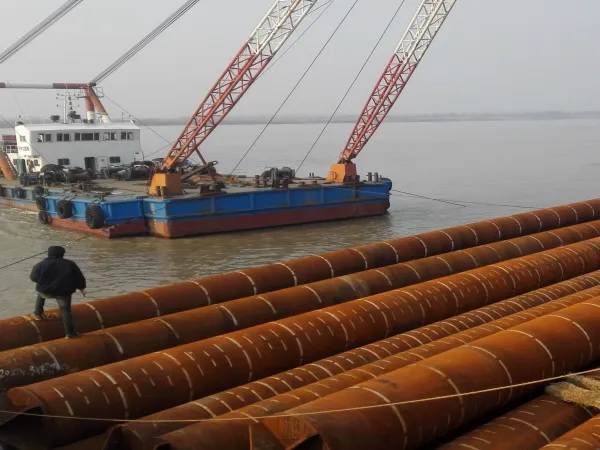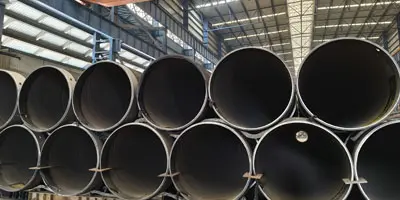Steel pipe piles are vital components in foundation engineering, widely used in bridges, docks, and high-rise buildings due to their high strength, durability, and ease of construction. Different types of steel pipes, including
SSAW pipes,
LSAW steel pipe and welded steel pipes, can serve as steel pipe piles. However, various issues often arise during construction, potentially affecting progress and quality. This article explores common problems in steel pipe pile construction and offers practical solutions to improve project efficiency and outcomes.
Steel Pipe pile properties
The characteristics of steel piles are: (1) light weight, good rigidity, easy loading, unloading, transportation, and stacking, and not easy to damage; (2) high bearing capacity. Due to the high strength of steel, it can be effectively driven into hard soil layers, the pile body is not easy to damage, and a large single pile bearing capacity can be obtained; (3) the pile length is easy to adjust. The pile length can be adjusted by extension or cutting as needed; (4) the amount of soil discharge is small, and the impact on adjacent buildings is small.
Steel pipe piles foundation construction problems and solutions
Problem 1: Pile Fractures
Pile fractures occur due to factors such as insufficient concrete strength, deviations in pile lifting points, hard underground obstacles, or excessive hammering force during pile driving.
Solutions to Prevent Pile Fractures:
Improve Concrete Quality:
Ensure proper aggregate grading and concrete workability during pile fabrication. The pouring and interval times should not exceed the initial setting time of the concrete, and the pile must meet requirements for strength and straightness.
Enhance Drilling Mud:
For piles in sandy layers, use additives like bentonite, hydroxyethyl cellulose, lignosulfonates, or sodium carbonate to improve slurry adhesion and wall stabilization.
Control Pile Spacing:
Avoid excessive piling density. Maintain a spacing of at least four times the pile diameter. For spacing less than 3.5 times the diameter, stagger the installation to prevent structural issues.
Problem 2: Obstructions During Steel Pile Installation
Steel piles may encounter underground obstacles like boulders, which hinder proper penetration, affecting both construction progress and pile continuity.
Solutions:
Adjust the Pile Path: Where feasible, use a curved alignment to bypass obstacles while maintaining structural continuity.
Use Enhanced Equipment: Employ higher-powered piling equipment, combined with water jets or rotary drilling rigs, to break through obstacles.
Problem 3: Difficulty Driving Piles into Soil
Driving steel pipe piles into dense soil layers or encountering obstacles such as gravel or rock can increase resistance, prolonging the timeline and risking damage to pile tips or equipment. Poor pile tip design can exacerbate the issue.
Solutions:
Pre-Drilling Method:
Remove soil obstacles by pre-drilling holes, reducing resistance for easier pile insertion.
Upgrade Pile Tip Design:
Add open-ended cutting shoes or pointed drill bits to pierce hard soil layers effectively.
Optimize Hammering Techniques:
Increase hammering energy or use vibration hammers to improve penetration.
Problem 4: Welding Quality Issues
The structural integrity of steel pipe piles depends heavily on weld quality. Common problems include weld cracks, porosity, or undercuts, often resulting from improper techniques or unsuitable welding materials. For instance, low temperatures during welding can lead to brittle welds.
Solutions:
Strict Adherence to Standards: Follow welding protocols and use appropriate materials.
Non-Destructive Testing (NDT): Conduct ultrasonic or radiographic testing to detect flaws.
Layered Welding Techniques: Apply multi-layer welding for critical joints to enhance weld strength and flexibility.
Problem 5: Damage to Pile Structure
Steel pipe piles may deform or crack due to excessive force, substandard materials, or improper handling, increasing costs and compromising safety.
Solutions:
Use High-Quality Steel: Select certified materials that meet standards, and conduct thorough inspections, including chemical composition analysis and mechanical performance tests.
Control Hammering Energy: Avoid excessive impact forces during pile driving.
Protective Coatings: Install protective sleeves to enhance durability and resistance to damage.
Problem 6: Vibration Impact on Nearby Structures
Pile driving may cause vibrations that disturb adjacent buildings or underground utilities, potentially leading to cracks or settlement.
Solutions:
Mitigate Soil Compression: Use methods like shallow anti-compression trenches or sand drains near structures. Fill trenches with foam, sand, or loose materials to absorb vibration waves.
Optimize Piling Equipment: Use equipment with low-intensity, high-frequency vibrations and add dampening layers to reduce impacts.
Pre-Construction Surveys: Inspect nearby buildings and implement temporary reinforcements where necessary.
Problem 7: Inadequate Pile Penetration Depth
Steel pipe piles may fail to reach design depth due to insufficient hammer energy, dense soil layers, or underpowered equipment.
Solutions:
Upgrade Equipment: Use high-powered hydraulic hammers or large vibratory hammers to enhance penetration.
Assist with Auxiliary Methods: Employ techniques like high-pressure water jetting or hole boring to loosen compact soil layers.
Real-Time Monitoring: Use penetration depth monitoring tools to assess each hammering cycle, ensuring compliance with design specifications.

Conclusion
While steel pipe pile construction is a well-established technique, challenging geological conditions and high project demands often lead to obstacles. Understanding common issues and applying scientifically proven solutions can significantly improve construction efficiency, safety, and quality. With proper planning and execution, steel pipe pile foundations can ensure the stability and longevity of major infrastructure projects.
At Baowi Steel, we provide a wide range of high-quality steel pipe piles designed to meet the demands of your construction projects. Our steel pipe pile catalogue includes detailed specifications, including steel pipe pile sizes, weight, and a comprehensive steel pipe pile size chart, making it easier for you to select the right product. We offer steel pipe pile design examples to help guide your foundation design, ensuring optimal performance. Our steel pipe pile wall solutions deliver superior stability, and our expert team is ready to provide tailored solutions to suit your specific needs. Trust Baowi Steel, your reliable steel pipe pile manufacturer, for durable and efficient products that enhance your construction's structural integrity. For more details, download our steel pipe pile catalogue PDF today!






 English
English Español
Español بالعربية
بالعربية











 Phone :
Phone :  Whatsapp :
Whatsapp :  Email :
Email : 


